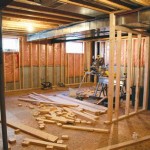Insulating Basement Walls With Rigid Foam: Essential Aspects
Insulating basement walls with rigid foam is a highly effective method to increase the energy efficiency of your home. By reducing heat loss and moisture penetration, rigid foam insulation can create a more comfortable and healthy living environment while lowering energy costs. Here are some essential aspects to consider when insulating basement walls with rigid foam:
1. Choosing the Right Foam:
There are two main types of rigid foam insulation commonly used for basement walls: extruded polystyrene (XPS) and polyisocyanurate (polyiso). XPS is a blue or pink foam that is moisture-resistant and durable. Polyiso is a yellow or orange foam that has higher R-values (insulating ability) but is more expensive. Consider the specific requirements of your basement, such as moisture levels and budget, when selecting the type of foam.
2. Preparing the Walls:
Before installing rigid foam insulation, it is crucial to prepare the basement walls properly. Remove any dirt, debris, or mold from the walls and repair any cracks or gaps. Moisture control is also important. Consider installing a vapor barrier or drainage system if your basement is prone to moisture problems.
3. Installing the Insulation:
Rigid foam insulation is typically installed using mechanical fasteners or adhesive. When using fasteners, ensure they are long enough to penetrate the foam and secure it to the wall. For adhesive applications, follow the manufacturer's instructions carefully and apply the adhesive evenly to the foam and wall surface.
4. Sealing and Finishing:
Once the rigid foam insulation is installed, it is essential to seal any gaps or seams between the foam sheets. Use foam sealant or caulk to fill any voids and prevent air or moisture infiltration. Finishing the insulation with a layer of drywall or another appropriate material will give your basement walls a clean and finished look.
5. Benefits of Insulating Basement Walls:
The benefits of insulating basement walls with rigid foam are numerous. It reduces heat loss, leading to lower energy bills and increased comfort levels. It helps regulate temperature and humidity, creating a more comfortable living space. Rigid foam insulation also acts as a moisture barrier, preventing water penetration and potential mold growth.
6. Professional Installation:
While it is possible to install rigid foam insulation yourself, it is recommended to hire a professional contractor. They have the expertise and experience to ensure a proper installation, maximizing the benefits of insulation and avoiding potential issues.
7. Cost Considerations:
The cost of insulating basement walls with rigid foam varies depending on the size of your basement, the type of foam used, and the cost of labor. However, the long-term savings on energy bills and increased comfort can make this investment worthwhile.
Conclusion:
Insulating basement walls with rigid foam is a valuable home improvement that offers several benefits. By implementing these essential aspects during the installation process, you can effectively improve the energy efficiency, comfort, and durability of your basement while reducing energy costs.

How To Install Rigid Foam Board Insulation On Basement Concrete Foundation Walls At Improvements

How To Insulate A Basement With Rigid Insulation Buildwithhalo Com

How To Insulate A Basement Wall Greenbuildingadvisor

Doe Building Foundations Section 2

How To Insulate A Basement With Rigid Insulation Buildwithhalo Com

Three Ways To Insulate A Basement Wall Fine Homebuilding

Etw Foundation 2 Xps 2x4 Framing With Fiberglass Batt Buildingscience Com

How To Insulate Your Basement Like A Pro

Three Ways To Insulate A Basement Wall Greenbuildingadvisor

How To Insulate Basement Walls With Rigid Foam And Should You Phoenix Insulation Pros
See Also








